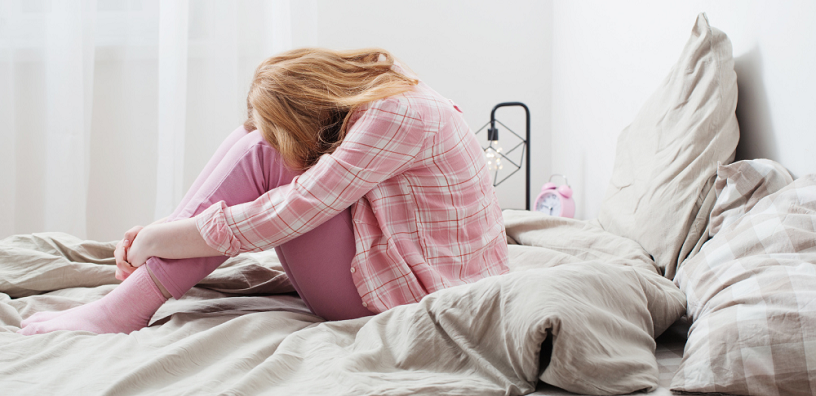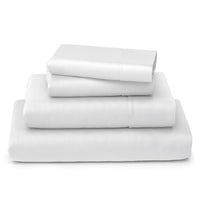
Is Your Bedroom Affecting Your Mental Health? 9 Tips to Turn Your Room into a Sanctuary
We all know getting a good night’s rest is crucial to living a happy, healthy life. But did you know your bedroom could affect not only how you sleep, but also your mental health?
May is Mental Health Awareness Month. So what better time to shed light on how your bedroom space can play a role in affecting your mental space?
Keep reading to learn why your bedroom may not best suit your mental health and ways you can transform your space and your mind.

The Link
When you don’t get a good night’s rest, your mood, cognitive function, and decision-making skills all can be affected.[1-4] And having a bedroom not set up for a healthy sleep environment is oftentimes the problem. People sleep better when their bedroom is optimized for comfort and incorporates certain important elements like temperature, light, and noise.[5]
Additionally, quality sleep is directly linked to other aspects of our health. So a bedroom that promotes sleep can ultimately affect how we feel while we’re also awake.
9 Tips to Transform Your Bedroom
1. Incorporate Essential Elements
- Temperature: A cooler temperature at night helps you maintain a lower core temperature, which helps you feel sleepy. According to experts, the ideal temperature to sleep at night is 65 degrees Fahrenheit. If that’s too chilly for you, a range of 60 to 71.96 degrees Fahrenheit should be suitable for the majority of sleepers.[5]
- Noise: Research shows that noise disturbances—loud or low ones—can disrupt your sleep which can, in turn, have negative impacts on your mental health. Your bedroom should be as quiet as possible by blocking outside noises. Try using a fan, white noise machine, ambient sounds, or soothing music. Soothing music actually has been shown to help alleviate anxiety, too.[6]
- Lighting: Circadian rhythms are also influenced by natural light and darkness. When it gets dark, your brain produces melatonin to induce feelings of relaxation and sleep. So keep your bedroom light levels as low as you can or use a dimmer. It is also suggested that you avoid screens and TVs, as artificial blue light can affect sleep as well.[7]
- Fragrance: Did you know that certain scents can help you feel more relaxed? Diffusing essential oils like lavender, peppermint, or heliotropin can boost sleep quality. Do you share your bed with your partner? If so, their unique scent may also help, especially if you have a hard time relaxing and sleeping when they’re not there.[8-10]

2. Declutter
Clutter and mess are the main cause of a cluttered, stressed mind. It makes the brain feel disorganized, which can affect your ability to think clearly and rationally. Out of sight, out of mind.
Go through your room and purge what you may not use any more, is worn and old, and any trash lying around. Donate what you can. Keep an empty or, at least, a well-organized dresser or nightstand top. Store things you want to hold onto or clothes that aren’t in season either under your bed in containers or another space in your home. Give yourself, and your mind, some space to just relax in your sanctuary.
3. Sleep-Only Zone
If you’re limited on space, this one may be difficult, especially if you work from home. Do your best to not work from your laptop in bed. Instead, if absolutely necessary, try to make a dedicated space in your room for your workspace.
But why is this important? Research shows that if your bedroom is a room full of activities, your brain will consider it a place of activity and potential stress rather than relaxation.
If you engage in any activities in your room, keep them calming ones, like listening to soft music, reading, or getting ready.

4. Quality Bedding
Simply choosing the right bedding can boost your quality of sleep. And who doesn’t love crawling into a bed made with soft, comfortable bedding? You should choose your bedding based on personal preference, but there are a few features you might want to look for to promote better sleep overall.
Here’s what you should look for in each bedding item:
- Mattress Protector: Many people opt out of using a mattress protector, or they just don’t think about adding it to their bedding collection. However, if you want to promote optimal sleep hygiene, we highly recommend one. They act as a physical shield protecting your mattress from everyday wear and tear, spills, and even bed bugs (if you get a mattress encasement). And a mattress protector like Cosy House’s is made with fabric that isn’t crinkly, noisy, or traps heat, so you don’t have to compromise your comfort or your sleep quality.
- Bed Sheets: Night sweats are a common and stressful anxiety symptom. Night sweats can cause you to toss and turn, wishing you could just fall asleep. If that is something you deal with, find sheets that are moisture-wicking and temperature-regulating, like Cosy House’s Luxury Sheets. The bamboo viscose blended material is breathable, soft, and can help keep you cool and comfortable all night long.
- Pillow: Top three things to look for in a pillow are firmness, loft, and durability. Finding the perfect pillow for you can be difficult, and oftentimes, a trial and error situation. So we recommend using an adjustable pillow, like our Luxury Pillow. This allows you to customize your comfort and figure out what works best for you without having to try multiple different pillows. The shredded memory foam in our pillow can be removed or re-added to get the perfect comfort, and it is ultra-supportive, allowing you to get some much needed rest.
- Blanket: If you suffer from anxiety or depression, a weighted blanket may be beneficial for you. Weighted blankets, like the one from Cosy House, work to calm the nervous system by engaging key relaxation pressure points. Designed to stimulate these points on the body, one can expect improved sleep, mood, and relaxation. This “Deep Pressure Stimulation” increases the release of serotonin and melatonin while reducing cortisol — a stress hormone. This slows your heart rate and puts your autonomic nervous system into rest mode. It’s basically a full-body hug, whenever you want.
5. Keep Your Room Clean & Fresh
When your mental health is suffering, oftentimes the last thing on your mind or want to do is cleaning and laundry. But keeping your bedroom clean and fresh is important for promoting healthy sleep. Aim to wash your bedding once per week. While your bedding is in the wash, take a moment to vacuum and dust your room. Keeping your room clean can also help reduce anything that can potentially trigger allergies.

6. Make Your Bed Each Day
While making your bed each day may sound like an unnecessary chore, it can reap many benefits in terms of your mental health. Remember how we discussed how a clutter-free environment can improve your mental clarity and stress levels? Making your bed helps your room look orderly and tidy.
Studies on personal and household hygiene show that people who are more organized and tidy tend to have a more goal-oriented, conscientious, and aware mind. Another study shows that our physical environments and their orderliness can impact our general sense of well-being.[11,12]
7. Choose Relaxing Colors
Many interior designers use something called color therapy, which is a form of therapy that uses color to help treat both physical and mental health, and it dates back all the way to ancient Egypt. Colors have real effects on people, so why not take advantage of it?
Choose colors for your bedroom that bring you a sense of calm and balance. Here’s what colors experts found to help create a calm environment:
- Blue: Shown to reduce respiration and heart rate and create feelings of calmness and serenity[13]
- Green: Shown to promote relaxation, sleep, and tranquility due to the fact it's reminiscent of nature[14]
- Neutrals: Creates a peaceful environment
The best rule of thumb is to avoid vibrant colors and glossy paint. Glossy finishes reflect light, which can stimulate the brain. Vibrant colors are considered uplifting, energetic colors. So save these for other parts of your home if you wish to incorporate them, like your home office or your child’s play area.

8. Add Some Plants
Did you know that greenery can help induce sleep and promote soothed, comfortable, and natural feelings? Research shows that active interactions with indoor plants can help reduce psychological and physiological stress.[15] They naturally filter air pollutants, also. Many things in our home can pollute our indoor air, such as insulation, furniture, or paint. Plants absorb harmful gases through pores in their leaves, cleaning and filtering your air. And as an added bonus, they just look nice!
Some great plants to keep in your bedroom include Gardenia, Peace Lily, and Areca Palm. If you’re looking for more easy-going hard-to-kill plants, try English Ivy, Heart Leaf Philodendron, Aloe Vera, or a Snake Plant.
9. Make it YOURS
It’s fun to follow trends, but also remember to make your bedroom YOURS. Decorate it in a way that reflects you and the things you like (but remember, try to keep the clutter to a minimum!). Don’t forget to give yourself a little grace if you need to work on reimagining your bedroom. Not everything has to be perfect or done at once. Thinking so also isn’t good for your mental health.

Time to Transform Your Space
Ready to turn your bedroom into the ultimate oasis? Let Cosy House help. Click here to start finding the perfect bedding and other home essentials to help you live your best, cozy life.
We've gone ahead & enclosed a 10% off coupon below for you to use if you'd like to take the plunge and try out our sheets for yourself! To shop our collection & get 10% OFF Use the code 'BLOG10' at checkout.
What ways do you make your bedroom a peaceful, zen sanctuary? Let us know in the comments! We love hearing from our Cosy Community!
Resources:
- Krause, A. J., Simon, E. B., Mander, B. A., Greer, S. M., Saletin, J. M., Goldstein-Piekarski, A. N., & Walker, M. P. (2017). The sleep-deprived human brain. Nature reviews. Neuroscience, 18(7), 404–418. https://doi.org/10.1038/nrn.2017.55
- Eugene, A. R., & Masiak, J. (2015). The Neuroprotective Aspects of Sleep. MEDtube science, 3(1), 35–40.
- Li, L., Wu, C., Gan, Y., Qu, X., & Lu, Z. (2016). Insomnia and the risk of depression: a meta-analysis of prospective cohort studies. BMC psychiatry, 16(1), 375. https://doi.org/10.1186/s12888-016-1075-3
- Oh, C. M., Kim, H. Y., Na, H. K., Cho, K. H., & Chu, M. K. (2019). The Effect of Anxiety and Depression on Sleep Quality of Individuals With High Risk for Insomnia: A Population-Based Study. Frontiers in neurology, 10, 849. https://doi.org/10.3389/fneur.2019.00849
- Libert, J. P., Bach, V., Johnson, L. C., Ehrhart, J., Wittersheim, G., & Keller, D. (1991). Relative and combined effects of heat and noise exposure on sleep in humans. Sleep, 14(1), 24–31. https://doi.org/10.1093/sleep/14.1.24
- Trahan, T., Durant, S., Müllensiefen, D., & Williamson, V. (2018). The music that helps people sleep and the reasons they believe it works: A mixed methods analysis of online survey reports. PLoS One, 13(11)., Retrieved from https://pubmed.ncbi.nlm.nih.gov/30427881/
- Tosini, G., Ferguson, I., & Tsubota, K. (2016). Effects of blue light on the circadian system and eye physiology. Molecular Vision: Biology and Genetics in Vision Research, 22, 61–72., Retrieved from https://www.ncbi.nlm.nih.gov/pmc/articles/PMC4734149/
- Lillehei, A. S., Halcón, L. L., Savik, K., & Reis, R. (2015). Effect of Inhaled Lavender and Sleep Hygiene on Self-Reported Sleep Issues: A Randomized Controlled Trial. Journal of Alternative and Complementary Medicine, 21(7), 430–438., Retrieved from https://pubmed.ncbi.nlm.nih.gov/26133206/
- Sowndhararajan, K., & Kim, S. (2016). Influence of Fragrances on Human Psychophysiological Activity: With Special Reference to Human Electroencephalographic Response. Scientia Pharmaceutica, 84(4), 724–752., Retrieved from https://pubmed.ncbi.nlm.nih.gov/27916830/
- Hofer, M., & Chen, F. (2020). The Scent of a Good Night’s Sleep: Olfactory Cues of a Romantic Partner Improve Sleep Efficiency. Psychological Science, 31(4), 449–459., Retrieved from http://journals.sagepub.com/doi/10.1177/0956797620905615
- Aunger R, Greenland K, Ploubidis G, Schmidt W, Oxford J, Curtis V. The Determinants of Reported Personal and Household Hygiene Behaviour: A Multi-Country Study. PLoS One. 2016;11(8):e0159551. doi:10.1371/journal.pone.0159551
- Sander E (Libby) J, Caza A, Jordan PJ. Psychological perceptions matter: developing the reactions to the physical work environment scale. Building and Environment. 2019;148:338-347. doi:10.1016/j.buildenv.2018.11.020
- Costa, M., Frumento, S., Nese, M., & Predieri, I. (2018). Interior Color and Psychological Functioning in a University Residence Hall. Frontiers in psychology, 9, 1580. https://doi.org/10.3389/fpsyg.2018.01580
- Kurt, S., & Osueke, K. K. (2014). The Effects of Color on the Moods of College Students. SAGE Open, 4(1). https://doi.org/10.1177/2158244014525423
- Lee, M. S., Lee, J., Park, B. J., & Miyazaki, Y. (2015). Interaction with indoor plants may reduce psychological and physiological stress by suppressing autonomic nervous system activity in young adults: a randomized crossover study. Journal of physiological anthropology, 34(1), 21. https://doi.org/10.1186/s40101-015-0060-8



